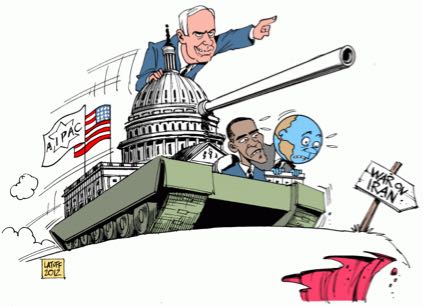
When we see headlines like, “US, Turkish Troops Headed For Military Showdown In Syria,” and its multiple variants. One might be forgiven if one wonders, “Afghanistan, Iraq, Libya…..what in the world is the U.S. now doing fighting Turkey in Syria? Will this madness never end?” The headlines only make sense in the framework of the neocon a.k.a. Global Elite a.k.a. Illuminati plan for world domination.
This essay is adapted from John Hamilton’s new book False Flags, State Secrets, Government Deceptions: A Short History of the Modern Era
by John Hamilton
(henrymakow.com)
The CIA plotted the military coup that toppled Iran’s democratically-elected prime minister, Mohammed Mossadegh, an ardent nationalist, and returned the Shah of Iran to power in 1953.
Why the coup? It was Mossadegh’s plan to nationalize the Western-owned oil fields and make them profitable for Iran. The U.S. and Britain found this unacceptable.
A bit of background to set the stage for yet another story of U.S. intervention in a foreign nation, and the hypocrisy of the U.S. reverence for “democracy.” U.S. reverence, in reality, has always been reserved for gathering dollars. Everything else: a myth.
BACKGROUND
The roots of Western involvement in Iranian oil go way back to 1901 when one William Knox D’Arcy, a wealthy London socialite, negotiated an oil concession with Mozaffar al-Din Shah Qajar of Persia. D’Arcy had made his fortune from share ownership in the Mount Morgan mine, Queensland, Australia. Why not increase it even more in Persia? That was the thinking.
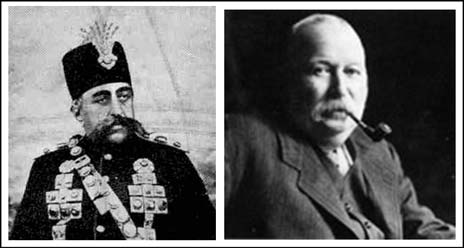
D’Arcy got exclusive rights to prospect for oil across most of Iran. Term: 60 years. The Shah got £20,000 (equal to something like £2.3 million today), an equal amount in shares of D’Arcy’s company, and a promise of 16% of future profits.
For a while, it looked like the Shah got the best of the deal. The oil was out there, under the sand, but proving very hard to find.
D’Arcy had hired geologist George Bernard Reynolds to do the actual work, and it was back- and heart-breaking work. Reynolds encountered miserable conditions: bandits, warlords, 100 degree-plus temperatures, smallpox outbreaks, and a lack of water. And, not only miserable, this oil exploration was an expensive business, too. Rich as D’Arcy was, Reynolds eventually went through enough of the D’Arcy fortune that D’Arcy threw in the towel. He sold most of his shares to Glasgow-based Burmah Oil Co. He wired Reynolds to stop work, liquidate assets and come home. There was no oil to be had in Iran — or so it seemed.
A persistent fellow, Reynolds delayed a bit, and pressed on just a bit further. Amazingly, within days, he found oil May 26, 1908; it was the same month D’Arcy had sold out.
The lucky beneficiary and new owner, Burmah Oil, created a public subsidiary and named it Anglo-Persian Oil Company (APOC), April 14, 1909. Burmah sold shares to the public. The business was successful.
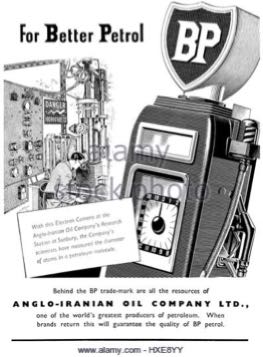
On behalf of the British navy, Lord of the Admiralty Winston Churchill became a new customer of APOC in 1913. So big, in fact, that eventually the British government became APOC’s largest shareholder. The company was renamed Anglo-Iran Oil Company (AIOC) in 1935. Another name change would come in 1954, to British Petroleum.
After World War II, nationalism was on the ascendant in Iran. Foreign-owned companies like AIOC were subject to grievances like poor working conditions and relatively-small royalties paid to Iran. In 1947, for example, AIOC reported after-tax profits of £40 million ($112 million), but at this time the contractual agreement entitled Iran to just £7 million or 17.5% of profits. (Recall the original agreement called for the Shah to get 16%, not much progress for the Iranians.) The locals were feeling exploited.
In March 1951, the conflict came to a head: the Iranian parliament voted to nationalize the Anglo-Iranian Oil Company (AIOC) and its holdings. Foreigners out! Mohammed Mossadegh was nominated by parliament and then named prime minister by the Shah April 28, 1951. It would be his task to fulfill the mandate.
In response to this turn of events, AIOC withdrew from Iran. Britain pressured other nations to boycott Iranian oil.
Negotiations with the new prime minister failed. Officials at the British Ministry of Fuel and Power wrote in September, 1951: “If we reached a settlement on Mossadegh’s terms, we would jeopardize not only British but also American oil interests throughout the world. We would destroy prospects of the investments of foreign capital in backward countries. We would strike a fatal blow to international law. We have a duty to stay and use force to protect our interest … We must force the Shah to bring down Mossadegh.”
So the money was at stake, but even more so was an entire way of life, the Western business model of ‘investing capital in backward countries,’ in their own words.
MOSSADEGH
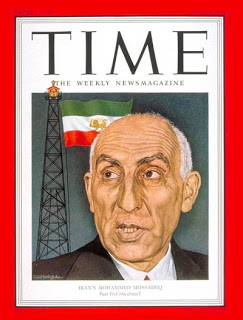
For his part, Mohammed Mossadegh was anything but backward. Born to a wealthy family, he was educated in France and Switzerland and earned a Ph.D. in law. On a visit to the U.S., October 1951 Mossadegh presented a complex proposal to break the logjam. He even proposed to buy out the Western capitalists. Nevertheless, it was rejected.
American and British interests thought it a simpler and better solution to get rid of Mossadegh.
So a counter-plot was born, according to a 1954 CIA document.
Yielding to pressure from the West, the Shah himself dismissed Mossadegh in mid-1952. The result: huge public riots. Mossadegh was re-installed, now with even more prestige.
Meanwhile, the CIA wrote up a royal decree for the Shah to sign to change the government, but timid, or indecisive, or both he resisted. Not taking ‘no’ for an answer, the CIA employed both the Shah’s bolder twin sister, Princess Ashraf Pahlevi and Gen. H. Norman Schwarzkopf, the father of the Desert Storm commander, to act as intermediaries to shore up the Shah.
It didn’t work. As the situation, and more riots, were heating up, the Shah left the country “for medical reasons.” The British Secret Intelligence Service (SIS), too, backed away at this time, but the CIA kept chipping away, putting together an amalgamation of pro-Shah and military forces.
It worked. On August 19, 1953, the Iranian military, backed by street protests organized and financed by the CIA, overthrew Mossadegh.
The Shah now felt safe to come home and take power. In gratitude for the assist, he turned over 40 percent of Iran‘s oil fields to a consortium of companies. The ownership group was incorporated in London, and comprised of the following: British Petroleum (40%), Gulf Oil (8%), Royal Dutch Shell (14%), and Compagnie Française des Pétroles (later Total S.A., 6%). Four Aramco partners–Standard Oil of California (SoCal, later Chevron), Standard Oil of New Jersey (later Exxon), Standard Oil Co. of New York (later Mobil, then ExxonMobil), and Texaco–each held an 8% stake in the holding company.
Mossadegh served three years in prison and then was under house arrest for the rest of his life. He died in 1967.
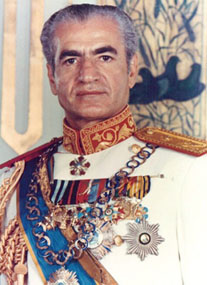
(left, Mohammed Rez Pahlavi)
For his part, the Shah would remain a U.S. ally until 1979, when nationalism stirred again, this time expressed as the Islamic Revolution, and he was finally overthrown by angry militants. The militants seized the U.S. embassy and held 444 American staff hostage until January 1981.
CONCLUSION
Why does the U.S. have a fractious and adversarial relationship with Iran to this day? This history gives some insight. And so do the plans the hawkish, war-mongering “neocons” hold for the future of Iran.
In a 2007 interview with Amy Goodman, host, Democracy Now!, Gen. Wesley Clark cites a classified Pentagon plan he was told of by a former subordinate, but not shown, that would “take out” Mideast nations “Iraq, and then Syria, Lebanon, Libya, Somalia, Sudan and, finishing off, Iran.” Only in this context does U.S. involvement in the Syrian Civil War make sense. Or our continuous conflict with Iran. It is part of a broader neocon, global elitist plan to rule the world.
Ruling other peoples, and accessing their wealth, i.e., colonialism, oppression, tyranny, is a lucrative, but ultimately dangerous business with the enormous potential to backfire. Much like most other crimes…
Related-
Source Article from https://www.henrymakow.com/2018/02/iran-illluminati-target.html
Related posts:
Views: 0
 RSS Feed
RSS Feed
















 February 17th, 2018
February 17th, 2018  Awake Goy
Awake Goy  Posted in
Posted in  Tags:
Tags: 
















